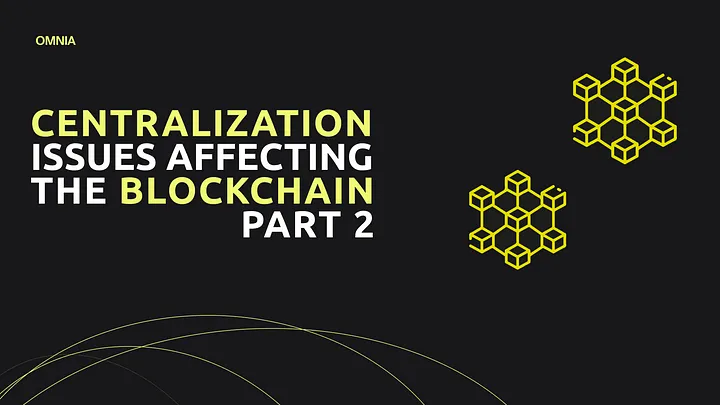
Centralization Issues Affecting Blockchain Technology — Part 2.
In our first installment exploring the centralization issues affecting the blockchain industry, we highlighted the challenges of having truly decentralized infrastructures when running the various networks. The OMNIA team pointed out that most nodes on the Ethereum Network are run through centralized cloud computing services, with Amazon Web Services (AWS) handling nearly 25% of all ETH nodes.
In addition, 34% of all Ethereum nodes are hosted in the United States because cloud computing providers have concentrated their infrastructure in the country. They include AWS, Microsoft Azure, Alibaba Cloud, Google Cloud, Digital Ocean, and Hetzner.
Such centralization, as with AWS dominance in the running ETH nodes, highlights a need for Data Center Diversity. A lack of which can cripple the Ethereum network due to outages as witnessed on December 8th, 2021. The additional centralization of cloud service providers located mainly in the United States highlights another concern for Geographic diversity.
Recent Events in DeFi Have Brought to Light Other Centralization Issues.
However, the ongoing crypto drawdown due to Bitcoin losing 74.4% of its value from its all-time high of $69k set in early November 2021 to the recent low of $17,600 has unearthed events whereby DeFi protocols that were meant to be decentralized ended up making centralized decisions to mitigate against liquidity crises.
One such example involved the team at the Solana-based Solend lending platform, initiating a governance proposal to grant the team emergency powers to control a SOL whale account facing liquidation on the platform. The Solend team justified the governance proposal by saying they had tried vainly to contact the whale. In addition, a liquidation of such magnitude was very risky and could cause a cascading effect on the liquidity of the lending platform, hurting all its users. The proposal was passed in one day with a notable decentralization anomaly of 90% of the vote belonging to one user.
The Solend team soon shelved plans for the proposal due to community backlash. The crypto market conditions also improved and reduced the risk of the whale’s liquidation. The SOL whale was also successfully contacted, and his position was modified to minimize the Solend platform risk by distributing his trades to other Solana DeFi platforms such as Mango Markets.
Other centralization issues have also emerged as a result of the crypto winter conditions and include the following:
- The crypto lending platform of Celsius Network paused all withdrawals, Swaps, and transfers on June 13th due to what they explained as ‘extreme market conditions’ that affected its liquidity and operations.
- Babel Finance suspended redemptions and withdrawals on June 17th due to what they stated as ‘major crypto market fluctuations’ that resulted in ‘unusual liquidity pressures.’
- CoinFLEX paused withdrawals on June 27th due to a liquidity crisis caused by a $47 million deficit caused by a high net worth individual owing the platform a similar amount.
Further Classification of Centralization Issues Facing Blockchain Technology.
As it so happens, and as all the events mentioned above were unfolding, a similar study on the magnitude of actual decentralization of blockchains was being concluded by the team at Trail of Bits in collaboration with the Defense Advanced Research Projects Agency (DARPA). The latter is a US Department of Defence agency tasked with researching and developing emerging technologies for use by the military.
The study, which took almost a year, focused on the two most popular blockchains of, Bitcoin and Ethereum and identified six ways such networks can be centralized.
1. Authoritative centrality.
Also known as Governance centrality, every blockchain has a set number of entities that can modify the blockchain and potentially change its operations. In most cases, these entities are blockchain developers, as was the case when Ethereum was attacked in 2016 through the DAO hack, resulting in a roll-back of transactions and the birth of Ethereum Classic, which kept the attack transactions. A similar authoritative centrality can be identified with the decisions by the Solend team highlighted above.
2. Consensus centrality.
In an ideal situation, the safety and security of any blockchain is tied to its off-chain governance or consensus mechanisms. Consensus centrality is often observed on consensus protocols with a small number of entities running their own centralized software with little to no on-chain governance.
Mining pools belonging to Proof-of-work blockchains can also become victims of consensus centrality through 51% attacks. In this instance, a malicious entity can plot to control the majority (51%) of the network and proceed to modify the blockchain as they see fit.
3. Motivational centrality.
This primarily involves the control of incentives that discourage participants of a blockchain network from acting maliciously. This is usually in the form of block rewards for miners in proof-of-work networks and validator rewards and penalties in proof-of-stake networks.
4. Topological centrality.
Most consensus networks have a set number of validator nodes needed to guarantee operations. The design and interdependence of these nodes can introduce single points of failure in the event one node fails or undergoes a malicious attack. Such events highlight the Topological centrality of a blockchain network.
5. Network centrality.
Network centrality explores the underlying network infrastructure’s impact on specific blockchain networks.
In the case of Bitcoin, 60% of its traffic traverses through three specific ISPs. Additionally, as of July 2021, about 50% of all public Bitcoin nodes were operating from IP addresses from autonomous systems in Germany, France, and the United States. 50%of Bitcoin’s traffic was also routed through Tor.
Such centrality can be used to orchestrate an eclipse attack: a type of denial of service attack targeting nodes to gain influence on a blockchain network.
6. Software centrality.
Blockchain networks routinely undergo software upgrades focused on improving several aspects of the chains, such as efficiency, security, and privacy, just to name a few. But not all participating nodes update their software as soon as upgrades are announced, leading to situations of old versions of code continuing to safeguard the security of such blockchains. Such software hiccups open the doors to weaknesses in the respective chains that can be exploited.
A good example can be found with mining pools that distribute client software to miners in the form of ‘black boxes.’ In most instances, third-party security auditors have never tested the code provided. Consequently, an attacker can remotely execute code in the mining pool client that either denies service to the mining pool or redirects the hashrate towards a 51% attack.
OMNIA’s Solution to Centralization.
The team at OMNIA has carried out further research on these centralized issues and is committed to addressing the weaknesses identified in existing blockchain networks.
OMNIA provides a decentralized infrastructure for users to privately and securely access the blockchain, focusing on preventing single points of failure that could disrupt blockchain applications or wallets integrating with it.
Concerning incentives to foster decentralization and maintenance of the OMNIA network, its design ensures that every node and privacy-relayer operator is rewarded accordingly for the services they provide. The rewards will further increase participation in the network and offer redundancies, thus preventing possible outages.

